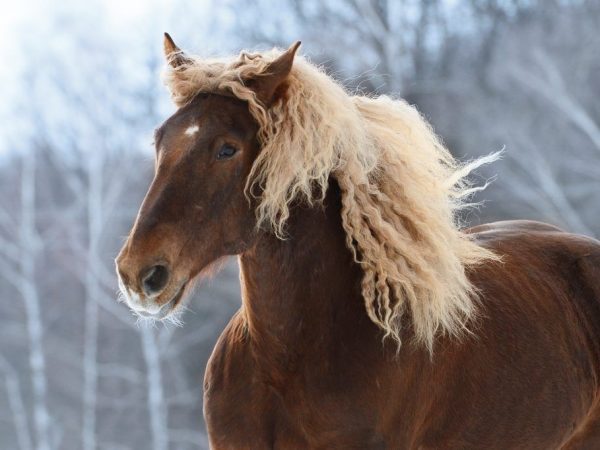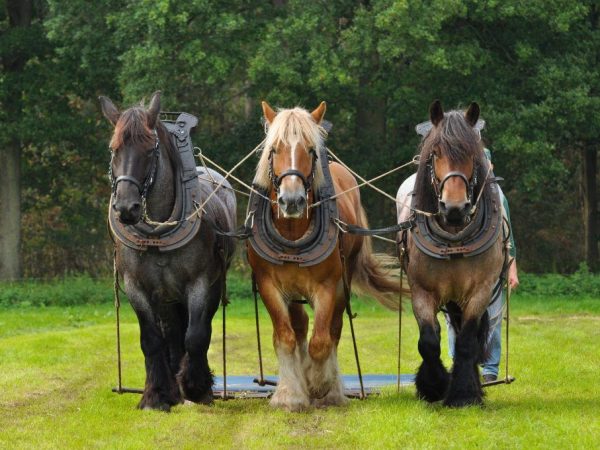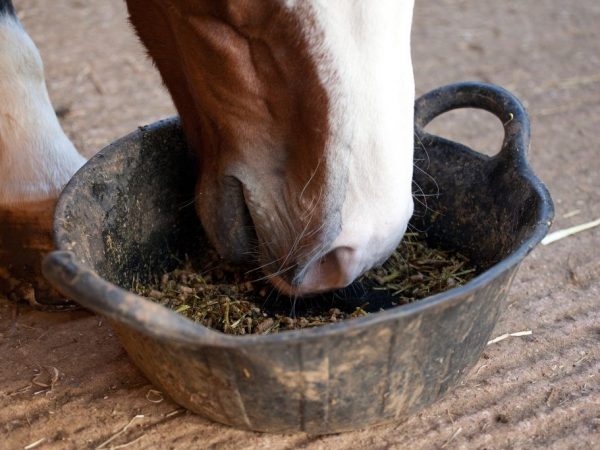Breed Soviet Heavy Truck
Since ancient times, the horse has faithfully served man. There are different breeds of horses, the differences between them depend on the area of use. Often they resort to their help when pulling power or a means of transportation is needed. The undisputed leader among the strongest horses is the Soviet Heavy Loader.

Characteristics of horses of the Soviet Heavy Truck breed
This horse has long been used in the agricultural industry as an alternative to expensive equipment. Powerful horses easily pulled field plows and transported heavy loads over long distances. Horse breeders were able to instill in heavy haulers unpretentiousness, endurance and meekness.
Origin and use
The heavy draft horse has been known for a long time. It was used for agricultural needs, as well as as part of the heavily armed cavalry. The physical parameters of this type of horse were needed by people all over the world, which gave rise to many lines of this type of stallion.
In the USSR, at the Pechinka stud farm No. 23, its own breed of powerful horses was also bred, which were used in the agricultural industry. Scientists took the Belgian Brabancon as a basis and, through selection, improved its traction qualities and weight parameters. The Soviet heavy draft horse is officially considered the largest representative of its breed and an absolute record holder in traction capabilities.
Today, the Soviet Heavy Loader is little used by humans in agriculture, since the equipment requires less financial costs. However, this breed of horse is still used in logging after special training. The Soviet Heavy Loader is engaged in the transportation of felled logs in Russia, America and Canada.
A distinctive feature of this breed is its early maturity. When breeding heavy trucks, scientists kept the animals in the most stringent conditions, which is why this type of stallion is distinguished by its unpretentiousness and rapid maturation.
Some farmers raise Soviet Draft Trucks for slaughter. This type of horse is a source of large amounts of meat, and mares have a high milk yield. The price of horse meat is not too high on the foreign market, but breeders profit from the amount of the final product.
Horse exterior
The Soviet Heavy Loader does not have strict standards for hatching, as this species is not used at sporting events or parades. However, the established criteria for the appearance of the Soviet heavy truck still have:
- The growth of the animal usually reaches 160-170 cm at the withers, and the weight of one individual is up to one ton.
- The head of Soviet Heavy Drafts is of medium size, well-shaped, with well-developed nostrils.
- The ears are small, set at right angles.
- The clear rock profile should be convex.
- Heavyweights are characterized by a short neck and a powerful body.
- The back is arched and ends in a strong croup.
- The horse's legs are of medium length with pronounced joints.
- The hooves are short and wide, with a dense horny plate.
The coat of the Soviet Heavy Truck does not have a clearly defined color. This breed is characterized by bay, dun, red, black and roan colors. White markings on the muzzle are allowed. The mane and tail are thick, the color depends on the breed line.
Character
Among the character traits are:
- calmness;
- meekness;
- unpretentiousness;
- endurance.
The Soviet heavy loader treats people well and rarely shows aggression. Such character traits are the merit of the breeders who selected the most flexible stallions for breeding. Today, poise and phlegm are trademarks of the breed, so recalcitrant horses are not allowed to mate.

Horse character
The Soviet Heavy Loader does not tolerate rudeness and physical violence. You must not raise your voice to the horse, otherwise you can cause a panic attack in it. You should communicate calmly and confidently with Soviet Heavy Trucks. This species is good at distinguishing verbal commands, and a little encouragement will make them work harder.
The breed is famous for its high level of intelligence, due to which animals are used to work in sawmills. However, before this, the stallion must undergo training for a year: an unprepared animal can cause an accident and many victims.
Conditions of detention
Heavy horses are famous for their unpretentious maintenance. For this breed, a stall of 4 square meters is suitable. m, which is only 1 m more than that of a pony.
There are still some sanitary standards for keeping stallions:
- Drafts, strong odors and loud noise are not allowed in the room.
- Temperature and humidity levels should be stable regardless of the season.
- The den is cleaned daily, and the stable is washed once a week.
- When the season changes, the room should be disinfected with special preparations.
One of the prerequisites for keeping this breed is a pasture, where animals replenish their vitamin reserves.

Caring for horses of the Soviet Heavy Truck breed
If a Soviet heavy draft is used as a traction force, the horse must have a clear rest and work regime. A horse that works for wear and tear can experience stress, which reduces the animal's immunity.
After a day's work, the stallion should wash its hooves and clean out debris from its nostrils. This is especially true of breeds that work in logging. The horse's mane should be combed, otherwise parasites may start in the mats. To avoid this, some farmers prefer to braid their horses in braids.
Several times a year, the Soviet Heavy Truck must be examined by a veterinarian. The horse must go through a mandatory vaccination.
Diet of a heavy truck
Animals of this breed do not require delicacies in food, however, the diet of the Soviet Heavy Truck must be balanced, otherwise the stallion will not be able to do the job. A hungry Soviet heavy draft horse is sometimes unable to lift its own weight, so much attention is paid to feeding the stallions.
The daily ration of the Soviet Heavy Loader should contain the following products:
- Concentrated feed - 2 kg per day.
- Pure oats - 6 kg per day.
- Mixed grass hay - 6 kg per day.
- Juicy feed - 2 kg per day.
- Rye straw cutting - 0.5 kg per day.
- Ground flaxseed - 0.5 kg per day.
Avoid feeding pure straw to heavy draft haulers: this low-calorie feed easily clogs the horse's stomach. Before eating vegetables should be washed from the ground and cut into large pieces. Boil potatoes and beets before serving them to equids.
Stallions should not be fed too much succulent food as this can lead to an upset stomach. If horses are raised for meat, the feed should contain an increased amount of concentrates. It is necessary to monitor the quality of products. Mold, poorly dried hay, and unwashed vegetables can all cause gastrointestinal problems.
Special attention should be paid to vitamin and mineral complexes. Draft trucks have a high percentage of muscle mass and without the right amount of calcium in the body, they may have problems with the musculoskeletal system.
There are medications for improving bone tissue, but the following foods can also be used to replenish vitamins:
- bone and grass meal;
- fish fat;
- cake.
The Soviet heavy draft horse, like any horse breed, consumes a large amount of water. Drinking bowls for animals should always be clean and full. Dehydration of stallions can lead to death or disability.
Conclusion
The Soviet Heavy Loader is one of the largest equids. The breed was bred in the USSR at the breeding plant No. 23. These powerful horses were used to transport cargo and building materials over long distances. They also worked in the agricultural industry during the sowing season.
Today, heavy vehicles have been replaced by machinery, so the popularity of these horses has greatly decreased. In the modern world, powerful stallions are used in private farms, in logging and bred for slaughter. A large amount of food when keeping stallions at home pays off with the unpretentiousness of the horses.


